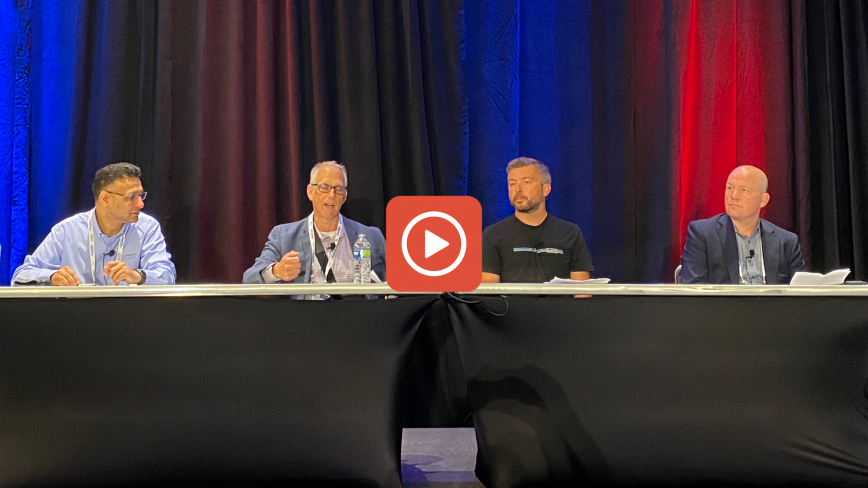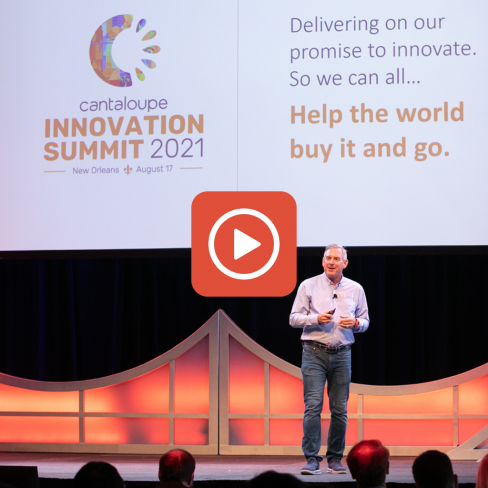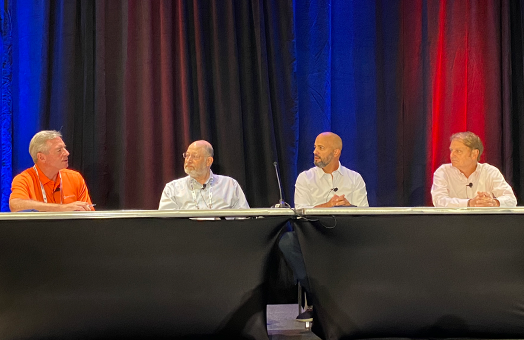This past August NAMA brought the industry back together in New Orleans. Although sparsely attended compared to normal years, those who were at the show were confident the industry is on the road to recovery. Cantaloupe, Inc. saw this optimism reflected in the discussions which were part of the different conference tracks, and the conversations that took place on the show floor and in the hallways. If anything, the industry is coming out of these past two years stronger and forging a path towards innovation like never before.
Consumer Trends Driving Adoption of the Unattended Retail Model
As a result of the smaller attendance, some of the show’s education forums were held virtually. One that shouldn’t be missed was a discussion looking at “Consumer Trends Driving Acceleration in the Adoption of Unattended Retail Models.” The online session was led by Cantaloupe’s own VP of Marketing, Elyssa Steiner, in conversation with Rebecca Speck, Lead Product Delivery at Discover® Global Network.
The pandemic had quite an impact on consumer behavior as it relates to purchasing of goods – from the goods themselves, to the methods of payment used in buying those goods. The unattended retail model found itself front and center, as consumers demanded a safer shopping experience. Retailers sought to implement digital and touchless payments, as well as unattended/self-serve capabilities, as quickly as possible. Pre-COVID-19, digital wallet acceptance was rather spotty in the US, but the onset of COVID-19 quickly saw significant increased adoption over a nine month period – at pre-pandemic rates, it would have taken at least three years to reach the same levels. Discover Global Network saw an 184% growth in contactless sales volume with the U.S., year over year (February 2020 to February 2021) and 67% active contactless active merchants in the U.S. use and acceptance changing perspectives. These demonstrate a great change in use and acceptance – a direct result of the pandemic. And Millennials seem to be the most likely to use digital wallets with the increase driven by concerns over health and safety.
Of those surveyed, 73% tried a new method. At least 75% will continue to use follow these new shopping habits. Cantaloupe found, in a survey conducted with CITE Research, that targeted more than 2000 US adults, that consumers didn’t shy away from unattended – 74% of respondents said COVID-19 did not impact their use of unattended and 14% saw an increase in their use of unattended.
What influences these trends, and will they continue post COVID-19? Convenience is at the heart of it all. Consumers want to be able to pay with any form of legal tender they have on hand. They also want to buy what their heart desires in the moment, at the point of sale. Health and safety concerns thrown in the mix have spurred the increase in demand for touchless solutions, 68% in fact, want the ability to “tap and go,” without having to punch in a code. And mobile phones are the epitome of convenience!
Payments and retail technology continues to evolve. It wasn’t that long ago that carbon paper credit card machines were still in every merchant location, despite the onset of the magstripe. QR codes seemed to be a flash in the pan in most places but Asia Pacific, however, the onset of the pandemic gave the technology new life. Today most consumers will access a QR code to read a menu, a list of services, or make payments; but it has quite a few uses and as a result, has staying power. Another segment of technology innovation is wearables, which allow you to pay with anything from your watch to your ring, or a microtag, among other items. Imagine the possibilities as cities evolve and technology gets even smarter! Add loyalty to that to create a stronger bond between brand and consumer. Shoppers like rewards and want to be rewarded for their commitment to a brand or product. Having an app that enables rewards at the point of sale, raises the possibility of engagement and use.
The bottom line is that consumers want options with convenience being the primary objective. Unattended retail gives consumers the ability to pay by any means possible in the moment and brands have the ability to engage and establish loyalty with unattended shoppers.
Becca and Elyssa shared some great stats during their talk, but we don’t want to ruin if for you. Make sure to tune in and learn more, we’ve made it easy for you via this link:

The Future of Convenience Services: Are you Now a Retailer?
So that dovetails nicely into the next session.
Cantaloupe CEO, Sean Feeney held a fireside chat with Marc Whitener; CEO of Refreshment Solutions; Josh Rosenberg, CEO of Threeboystrong LLC; and Mark Stein, Owner of Mark Vend. taking a look at how traditional and unattended retail are colliding and the new trends emerging as a result of this collision.
The panelists discussed how historically our industry was very single focused and siloed, but modernization and digital transformation have really helped elevate our segment. Unattended retail is well positioned as the digital footprint expands and walls are broken down to create a true omnichannel approach. Shopping is no longer a single destination experience. Today consumers are buying online, picking up in store, getting delivery, etc. Vending has a captive audience and has been leveraged tremendously during the era of COVID-19. Now, retailers can connect to the consumer right where they are in an unattended environment, something that was not been possible before, and leverage data to serve up what the shopper wants in the moment at the point of sale. Micro markets and pantry services also give retailers a broader spectrum.
Traditionally, vending has been limited by the number of skews, but the addition of these other mediums has allowed operators to support a broader selection of offerings. It has enabled many in the business to pivot and expand services during the pandemic, tailoring to the specific needs of a location served – think pop-ups or even food delivery at a work location. Vending has been able to fill in, complement, and elevate the standard offerings. And when you look at the effects of the pandemic, with the return to offices still a hanging question mark, it’s had a huge impact on the scale of our business and forced us to rethink our approach and really consider how we can help retailers reach that last mile in a different way – particularly one that is safe and secure. The modernization of vending through digitalization and the ability to capture data and offer such things as nutritional information and rewards changes the game.
The discussion also considered the impact of the future of work. There’s a good chance that work won’t look the same – not just here in the US, but all over the world. Unattended retailers need to understand and prepare for this shift. As work changes, our industry needs to better understand the consumers’ behavior, where and how they are working and what they are doing while there. There’s also the Amazon threat – it has shifted the paradigm and now consumers are disappointed at just near immediate gratification. You can get what you want in 24 hours, maybe next year that gratification time gets reduced to five or two hours – which is a reality in some markets already, via lockers and the company’s standalone self-serve shops. Amazon and other companies like it, have done a tremendous job at customizing the customer experience, but for that last mile, even Amazon can’t match what we operators do as a service provider – from a cost effectiveness perspective and segmentation. But Amazon is great at partnering and leveraging those relationships almost to the detriment of ours – it’s definitely a threat to watch.
So, what does the future hold? The industry will not go back to where it was pre-pandemic. Factors such as labor shortages, shifts in the consumer diaspora post pandemic, and upping the value proposition must all be seriously assessed by all of us in the business. Customization, specialization, and understanding the opportunities will be key to success going forward.
To hear the fireside chat in its entirety, please use your NAMA credentials to log on to the session here:

The New Landscape of Payments Acceptance
So what’s next? Ravi Venkatesan, Cantaloupe’s CTO,moderated a panel that looked at how the world of fintech has changed dramatically. The panel, which included Jeff Beach, VP of Merchant Sales and Solutions for Visa, Canteen’s Chief Strategy and Innovation officer, Mike Coffey, and Bakkt’s Chief Product Officer, Nicolas Cabrera; discussed which forms of payment might prevail in our markets, along with the future of cash in a world of digital payments, contactless payments systems, and cryptocurrency.
Obviously the question top of mind for everyone is what has the pandemic done to our industry in terms of changing the landscape, and what are the lasting effects it will have, particularly when it comes to payments and the seemingly rapid and drastic shift to digital and contactless payments? This swing was already in the making prior to COVID-19, with cash displacement becoming a more common occurrence, but the lockdown would accelerate it exponentially. At the height of it all, cash was perceived as “dirty” with many businesses refusing to accept it. On a side note – ironically the reduction in cash created a coin shortage. Nevertheless, both Visa and Canteen see the uptick in cashless and contactless payments here to stay. Canteen has seen an increase in cashless adoption from 30% in 2018 to about 64% now.
From cashless to contactless, digital payments and mobile wallets are now on the rise, resulting from a combination of the pandemic, and consumers clamoring for a frictionless experience. They want to buy what they want with any form of legal tender. Conversely, merchants want to create a point of engagement in order to foster loyalty. Bakkt is really looking to leverage that need by creating solutions that enable opportunities for both consumers, giving them more choice and control, as well as merchant and retailers; in an effort to use that moment of paying as more than just a monetary transaction, but a true opportunity to engage with the consumer.
In all of this push toward cashless and contactless, Canteen made the point that the extinction of cash is unlikely. We have to remember that there’s a very large portion of the population that remains unbanked. We forget that there are still many people who don’t have access to bank accounts, credit cards, rewards, and such. It’s also a regulatory issue, as governments – local, state, and federal – are taking steps to prevent exclusion.
So where do we see growth in contactless and what are the trends? As far as Visa is concerned tap and pay is at the forefront. There was a move toward contactless pre-pandemic and as it focuses on rolling it out in cities like New York, San Francisco, and San Jose. Mobile wallet apps like Apple Pay and Google Pay certainly help drive adoption as consumers become more comfortable with the idea of security and convenience found with their device. In NYC the Metropolitan Transit Authority (MTA) rolled out a new program that implements tap and pay – no more looking for a card, adding money or such – just tap your mobile phone and go. A great example of an open loop payment ecosystem.
Compass Group/Canteen is also leveraging “scan and go” with mobile payments in order to get closer to the consumer, but still offer a frictionless experience. It gives the consumer the ability to choose the way they want to pay. It also frees up that cashier to do something else, optimal during the labor shortage we are experiencing.
Bakkt is really looking to bring more assets to consumers who have more money to spend. Their spending power is something merchants and retailers want to harness. Take the Starbucks app, and its super cash – Bakkt brought the company alternate ways to pay, giving Starbucks the ability to tap into new customer segments. They’re younger, more tech savvy, and have crypto they want to spend. Despite the naysayers Starbucks saw value in saying, if you want a way to pay with crypto, which may be a stupid thing to pay for your coffee with crypto since it’s a taxable event, but some younger audience might want to do that and you know, as part of Bakkt’s infrastructure its platform supports crypto as a way to pay. Enabling new assets as a form to pay, it creates more flexibility.
Visa has seen over a billion in crypto enabled transactions. It’s more usable and becoming more commonplace. Crypto wallets have hundreds of billions of dollars and those who have it want to spend it. So, the company has made it easier for customers to use it. On the vending side, it does give operators some lift – but they have to be tech forward and understand the world is changing and ensure partners are also tech forward.
Every new payment type Cantaloupe enables, same location sales go up. An indicator that consumers want flexibility, convenience, and the ability to pay with anything from cash to crypto.
To listen to the discussion in its entirety, please use your NAMA credentials to log in here:


If these sessions indicate anything, it’s that exciting times are ahead in the world of payments and unattended retail. As we emerge from the last 20 months, traditional retailers have a bounty of solutions that can help drive better engagement through access, convenience, and loyalty. Cantaloupe is at the center of it, working hard to help the world buy it and go. Prior to NAMA we held our Innovation Summit, where we showcased a bevy of new products coming down the pipeline, for more information, please view the Innovation Summit press release.
